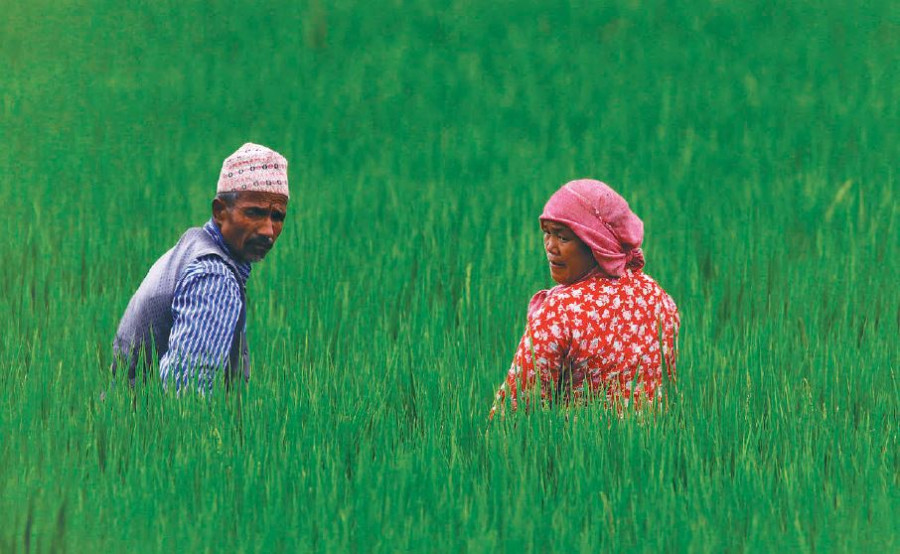National
Farmers complain of urea shortage nationwide, government says it’ll get the fertiliser within a week
Any delay would cripple production despite the gains of having 98 percent cultivation, the highest in the last five years.
Sangam Prasain
Farmer Sharum Raut’s paddy plants half submerged in the water have turned green after three weeks of transplantation. It’s time for topdressing his paddy with urea. But it’s not available in the country.
Raut was worried. Failure to get the nutrients meant his paddy would soon turn yellow. Raut, of Parsa district, took a risk.
He crossed the border into India to buy the fertiliser. But while returning, he was not only caught but also beaten up by police for illegally bringing in urea.
Tens of thousands of farmers like Raut rely on contraband fertilisers that used to pass easily into the country through the 1,700-kilometre leaky border with India. But this year, there are Covid-19 restrictions everywhere.
“I didn’t have an alternative. We need urea but the government is not giving us any,” said Raut.
With no supply, farmers across the country are frantic and urea is the most basic nitrogen fertiliser used in agriculture.
“Urea is the most essential nutrient for plant growth which supplies nearly half of its nitrogen need,” said Satya Narayan Mandal, a retired soil scientist. “Yellowing of leaves in paddy indicates the deficiency of nitrogen. Without it, plants get stunted and even die.”
If it is supplied too late it will be of no use.
“It’s already getting late to apply urea for the topdressing of paddy. We may lose production,” he said.
After three weeks of transplanting paddy, urea is spread on fields for top dressing. Normally in Nepal, chemical fertiliser is applied in three different stages—during transplanting, top dressing and second dressing when plants start flowering, which is 60 to 80 days after transplanting, depending on the seed quality.
Urea, the most commonly used fertilised in Nepal, is the cheapest and most efficient nitrogen fertiliser for the fields. At government subsidised rate it costs Rs14 per kg.
But farmers like Yadav are forced to pay two or even three times that price for the fertiliser smuggled from India.
In some districts like Jhapa, according to farmers, smuggled urea costs Rs50 per kg with crippling shortage and farmers desperate.
This year, farmers have been facing shortages of chemical fertilisers right from the beginning of the planting season. First there was a short supply of diammonium phosphate (DAP), the world's most widely used phosphorus fertiliser, as the Covid-19 pandemic disrupted the global production and supply chain.
Now, there is a shortage of urea.
Nepal depends totally on imported chemical fertilisers. In the last fiscal year, the country imported chemical fertilisers worth more than Rs 19 billion.
Agro experts say that the result of shortages in chemical fertilisers will hit production this year. This would have a far reaching impact.
In high yielding hybrid paddy, which needs a heavy dose of urea, if it is not applied in a timely manner and in required quantity, yield can drop as low as 75 percent, according to Mandal, the soil scientist.
Less production means higher import bill, higher inflation for the people, lower income for farmers, therefore lower consumption demand and eventually lower economic growth for the country.
Bijay Yadav in Rupandehi transplanted paddy without using chemical fertilisers because DAP was not available on time. Now he is again struggling to get urea for top dressing. Yadav is growing paddy on five bighas (0.8 hectares) and is worried that productivity will go down.
“That is certain. I will not get the production as expected,” Yadav said.
Yadav in Parsa risked police beating and crossed over to India to get urea but he failed. He usually used that option in the past when fertiliser was not available in the domestic market. But with the Covid-19 pandemic, the restrictions on cross-border movement were strict.
As the organic matter in Nepal’s soil is very low, even the local varieties of rice need sufficient amounts of urea, Mandal said.
Paddy is the key cereal crop in Nepal in terms of area, production and livelihood. According to the Department of Agriculture, rice supplies about 40 percent of the food calorie intake and contributes nearly 20 percent to the agricultural gross domestic product (AGDP) and 7 percent to GDP.
Farmers say that the timing of fertiliser application has a significant effect on crop yield. Proper timing of the fertiliser application increases output, reduces nutrient losses, increases nutrient use efficiency and prevents damage to the environment. Applying fertilisers at a wrong time would have an adverse effect with loss of nutrients, waste of fertiliser and even damage to the crop.
Last fiscal year, the government had increased the budget for the distribution of subsidised chemical fertilisers from Rs5 billion to Rs9 billion to ensure timely and sufficient supply. But it is still getting its act together and blames the Covid-19 pandemic for the delay in supply.
“There has been a slight delay for first top dressing,” said Hari Bahadur KC, spokesperson for the Ministry of Agriculture and Livestock Development. “This was a result of Covid-19 despite timely tenders on our part.”
A certain amount of urea is coming this week, he quickly adds.
According to him, 32,000 tonnes of fertiliser procured by the Salt Trading Corporation Limited will arrive this week and another consignment being imported by the Agriculture Inputs Company will come within a month.
Meanwhile, Sailendra Chaudhari, a farmer in Nawalparasi (West), has been doing the rounds of cooperatives in his district that distribute urea.
“But I have to return empty-handed every time,” he said.
There are 51 cooperatives authorised to distribute fertiliser in Nawalparasi, but none has the urea.
Earlier, during the transplanting season, he did not get DAP in time. “We were forced to transplant paddy using animal dung this year,” said Chaudhary.
Most of the fertiliser, however, does not come into Nepal through formal channels. According to the Agriculture Ministry, the annual demand for chemical fertiliser currently stands at more than 700,000 tonnes while official imports are just around 300,000 tonnes. Subsidised fertiliser covers 40 percent of the country’s total need while the rest is met by informal imports or shipments smuggled across the open border.
This fiscal year, the country completed its paddy transplantation on 98 percent of the available 1.37 million hectares, the highest transplantation recorded in the last five years due to timely and sufficient rainfall and availability of farm hands who returned home from foreign countries, the Ministry of Agriculture and Livestock Development said.
The hope of bumper paddy production, however, is certain to be dented due to the shortage of chemical fertiliser.
“It’s certain that we may lose some production as a result of chemical fertiliser shortage,” said Yadav of Rupandehi.
The government can only offer words to placate farmers.
“Now, we are making sure that the urea consignment is not delayed for the second dressing in mid-September,” said spokesman KC.
(Shankar Acharya in Parsa, Sanju Poudel in Tilottama and Nabin Poudel in Parasi contributed reporting)




 7.12°C Kathmandu
7.12°C Kathmandu















